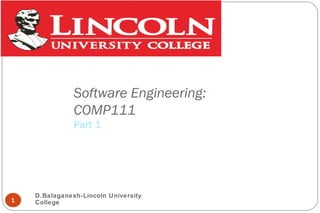Ch01-Introduction About Software Engineering
•Download as PPT, PDF•
1 like•1,070 views
Report
Share
Report
Share

Recommended
Recommended
More Related Content
What's hot
What's hot (15)
Autonomics Computing (with some of Adaptive Systems) and Requirements Enginee...

Autonomics Computing (with some of Adaptive Systems) and Requirements Enginee...
Introduction to Critical Systems Engineering (CS 5032 2012)

Introduction to Critical Systems Engineering (CS 5032 2012)
Similar to Ch01-Introduction About Software Engineering
Similar to Ch01-Introduction About Software Engineering (20)
chapter-1-software-and-software-engineering-software-engineering-a-practition...

chapter-1-software-and-software-engineering-software-engineering-a-practition...
Ijartes v2-i1-001Evaluation of Changeability Indicator in Component Based Sof...

Ijartes v2-i1-001Evaluation of Changeability Indicator in Component Based Sof...
Application Development and Emerging Technologies.pptx

Application Development and Emerging Technologies.pptx
More from Bala Ganesh
More from Bala Ganesh (20)
Recently uploaded
Recently uploaded (20)
Optimizing NoSQL Performance Through Observability

Optimizing NoSQL Performance Through Observability
Powerful Start- the Key to Project Success, Barbara Laskowska

Powerful Start- the Key to Project Success, Barbara Laskowska
What's New in Teams Calling, Meetings and Devices April 2024

What's New in Teams Calling, Meetings and Devices April 2024
Intro in Product Management - Коротко про професію продакт менеджера

Intro in Product Management - Коротко про професію продакт менеджера
Unpacking Value Delivery - Agile Oxford Meetup - May 2024.pptx

Unpacking Value Delivery - Agile Oxford Meetup - May 2024.pptx
SOQL 201 for Admins & Developers: Slice & Dice Your Org’s Data With Aggregate...

SOQL 201 for Admins & Developers: Slice & Dice Your Org’s Data With Aggregate...
The UX of Automation by AJ King, Senior UX Researcher, Ocado

The UX of Automation by AJ King, Senior UX Researcher, Ocado
Custom Approval Process: A New Perspective, Pavel Hrbacek & Anindya Halder

Custom Approval Process: A New Perspective, Pavel Hrbacek & Anindya Halder
Behind the Scenes From the Manager's Chair: Decoding the Secrets of Successfu...

Behind the Scenes From the Manager's Chair: Decoding the Secrets of Successfu...
Future Visions: Predictions to Guide and Time Tech Innovation, Peter Udo Diehl

Future Visions: Predictions to Guide and Time Tech Innovation, Peter Udo Diehl
Ch01-Introduction About Software Engineering
- 1. Software Engineering: COMP111 Part 1 1 D.Balaganesh-Lincoln University College
- 2. Chapter 1 Software and Software Engineering D.Balaganesh-Lincoln University College2
- 3. Software’s Dual Role D.Balaganesh-Lincoln University College3 Software is a product Delivers computing potential Produces, manages, acquires, modifies, displays, or transmits information Software is a vehicle for delivering a product Supports or directly provides system functionality Controls other programs (e.g., an operating system) Effects communications (e.g., networking software) Helps build other software (e.g., software tools)
- 4. What is Software? D.Balaganesh-Lincoln University College4 Software is a set of items or objects that form a “configuration” that includes • programs • documents • data ...
- 5. What is Software? D.Balaganesh-Lincoln University College5 software is engineered software doesn’t wear out software is complex
- 6. Wear vs. Deterioration D.Balaganesh-Lincoln University College6 idealizedcurve change actualcurve Failure rate Time increasedfailure rate duetosideeffects
- 7. Software Applications D.Balaganesh-Lincoln University College7 system software application software engineering/scientific software embedded software product-line software WebApps (Web applications) AI software
- 8. Software—New Categories D.Balaganesh-Lincoln University College8 Ubiquitous computing—wireless networks Netsourcing—the Web as a computing engine Open source—”free” source code open to the computing community (a blessing, but also a potential curse!) Also … (see Chapter 32) Data mining Grid computing Cognitive machines Software for nanotechnologies
- 9. Legacy Software D.Balaganesh-Lincoln University College9 software must be adapted to meet the needs of new computing environments or technology. software must be enhanced to implement new business requirements. software must be extended to make it interoperable with other more modern systems or databases. software must be re-architected to make it viable within a network environment. Why must it change?
- 10. Software Evolution D.Balaganesh-Lincoln University College10 The Law of Continuing Change (1974): E-type systems must be continually adapted else they become progressively less satisfactory. The Law of Increasing Complexity (1974): As an E-type system evolves its complexity increases unless work is done to maintain or reduce it. The Law of Self Regulation (1974): The E-type system evolution process is self-regulating with distribution of product and process measures close to normal. The Law of Conservation of Organizational Stability (1980): The average effective global activity rate in an evolving E- type system is invariant over product lifetime. The Law of Conservation of Familiarity (1980): As an E-type system evolves all associated with it, developers, sales personnel, users, for example, must maintain mastery of its content and behavior to achieve satisfactory evolution. The Law of Continuing Growth (1980): The functional content of E-type systems must be continually increased to maintain user satisfaction over their lifetime. The Law of Declining Quality (1996): The quality of E-type systems will appear to be declining unless they are rigorously maintained and adapted to operational environment changes. The Feedback System Law (1996): E-type evolution processes constitute multi-level, multi-loop, multi-agent feedback systems and must be treated as such to achieve significant improvement over any reasonable base. Source: Lehman, M., et al, “Metrics and Laws of Software Evolution—The Nineties View,” Proceedings of the 4th International Software Metrics Symposium (METRICS '97), IEEE, 1997, can be downloaded from: http://www.ece.utexas.edu/~perry/work/papers/feast1.pdf
- 11. Software Myths D.Balaganesh-Lincoln University College11 Affect managers, customers (and other non-technical stakeholders) and practitioners Are believable because they often have elements of truth, but … Invariably lead to bad decisions, therefore … Insist on reality as you navigate your way through software engineering
